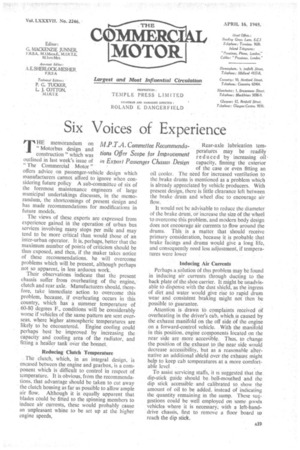Six Voices of Experience
Page 21

If you've noticed an error in this article please click here to report it so we can fix it.
THE memorandum on "Motorbus design and construction" which was outlined in last week's issue of "The Commercial Motor "• offers advice on passenger-vehicle design which manufacturers cannot afford to ignore when considering future policy A sub-committee of six of the foremost maintenance engineers of large municipal undertakings discusses, in the memorandum, the shortcomings of present design and has made recommendations for modifications in future models., The views of these, experts are expressed from experience gained in the operation of urban bus services involving many stops per mile and may tend to be more critical than would those of an inter-urban operator. It is, perhaps, better that the maximum number of points of criticism should be thus exposed, and then. if the maker takes notice of these recommendations. he will overcome problems which will, be present, although perhaps not so apparent, in less arduous work.
Their observations indicate that the present chassis suffer, from overheating of the engine. clutch and rear axle. Manufacturers should, therefore, take immediate action to overcome this problem, because, if overheating occurs in this country, which has a summer temperature of 60-80 degrees F., conditions will be considerably worse if vehicles of the same pattern are sent overseas, where higher atmospheric temperatures are likely to be encountered. Engine cooling could perhaps best be improved by increasing the capacity and cooling area of the radiator, and fitting a header tank over the bonnet.
Reducing Clutch Temperature The clutch, which, in an integral design, is encased between the engine and gearbox, is a component which is difficult to control in respect of temperature. It is obvious, from the recommendations. that advantage should be taken to cut away the clutch housing as far as possible to allow ample air flow. Although it is equally apparent that blades could be fitted to the spinning members to induce air currents, these would probably cause an unpleasant whine to be set up at the higher engine speeds. Rear-axle lubrication temperatures may be readily reduced by increasing oil capacity, finning the exterior of the case or even fitting an oil cooler. The need for increased ventilation to the, brake drums is mentioned as a problem which is already appreciated by vehicle producers. With present design, there is little clearance left between the brake drum and wheel disc to encourage air flow.
It would not be advisable to reduce the diameter of the brake drum, or increase the size of the wheel to overcome this problem and modern body design does not encourage air currents to flow around the drums. This is a matter that should receive primary consideration, because it is probable that brake facings and _drums would give a long life, and consequently need less adjustment, if temperatures were lower Inducing Air Currents Perhaps a solution of this problem may be found in inducing air currents through ducting to the back plate of the shoe carrier. It might be unadvisable to dispense with the dust shield, as the ingress of dirt and water would -give rise to rapid drum wear and consistent braking might not then be possible to guarantee.
Attention is drawn tb complaints received Of overheating in the driver's cab, which is caused by the exhaust manifold on the off side of the engine On a forward-control vehicle. . With the manifold in this position, engine components located on the near side are more accessible. Thus, to change the position of the exhaust to the near side would decrease accessibility, but as a reasonable alternative an additional shield Over the exhaust might help to keep cab temperatures at a more comfortable level.
To assist servicing staffs, it is suggested that the dip-stick guide should be bell-mouthed and the dip stick accessible and calibrated to, show, the amount of oil to be added, instead of indicating the quantity remaining in the sump. These suggestions could be well employed on some goods vehicleswhere it is necessary, with a left-handdrive chassis, first to remove a floor board to reach the dip stick.












































































